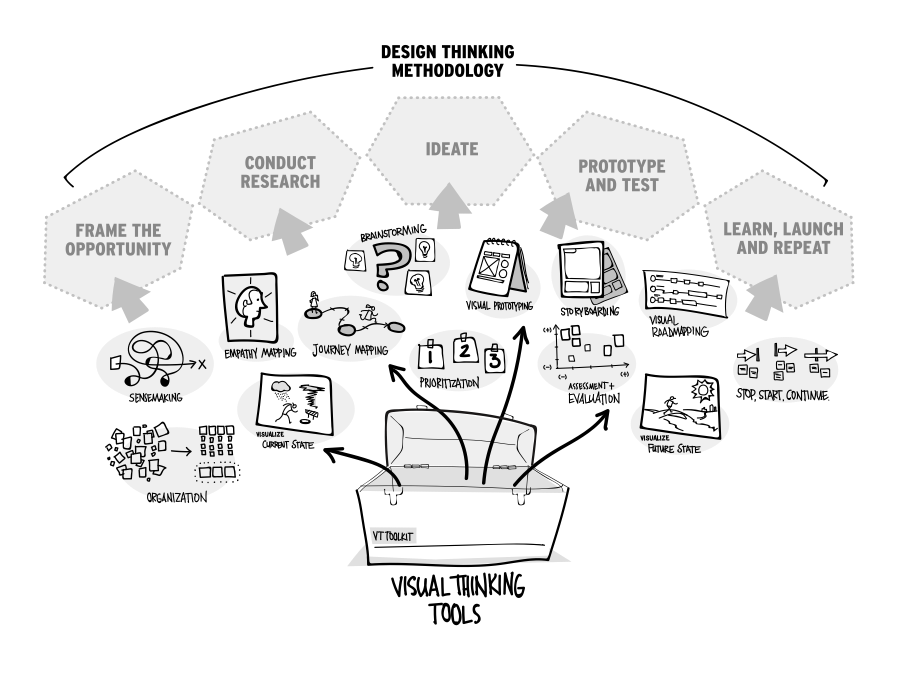At XPLANE we pride ourselves on bringing clarity to complexity. We usually do this for clients, but sometimes the need strikes closer to home. This happened recently at a social event when I heard the terms “design thinking” and “visual thinking” used interchangeably (not for the first time—and definitely not for the last). Now, most people who work in business strategy, innovation, or problem-solving can tell you that design thinking and visual thinking are not the same, but not everyone can easily articulate the difference. So in the interest of clarity and some serious cred at your next post-work cocktail hour, here’s a quick explanation of the difference between the two.
What is “design thinking”?
Simply put, design thinking is a method for problem-solving.
IDEO popularized the method in the early 1990s by applying it to product design. Since that time, a variety of design thinking approaches have been applied to an ever-increasing range of challenges. Think of it as a constellation of iterative steps and best practices rather than a specific process. Most of these approaches share the same basic activities:
• frame the opportunity, need, or problem
• conduct user-centered research to understand the human context
• ideate with multi-disciplinary teams
• prototype rapidly and test with users
• incorporate what you’ve learned, launch, observe, and repeat
What is “visual thinking”?
Visual thinking, on the other hand, is a set of tools for making intangible or complex ideas visible.
Most common among these tools is visualization (a.k.a. drawing—usually on whiteboards) and the ubiquitous Post-it® exercise. Lesser-known but equally powerful visual thinking tools include the use of objects, people, and/or spaces to physically represent information.
For practitioners—and anyone who has experienced a workshop that combines the two—it’s easy to see how visual thinking and design thinking complement one another. Visual thinking supports and accelerates design thinking. The clarity provided by visualization drives a shared understanding of goals and ideas—essential to defining and reframing issues. It also helps bring much-needed structure to the exploration of problems and the development of potential solutions. And for those who are willing to really jump in, visual thinking can even help increase the speed and testing of prototypes or even support frameworks for decision-making.
XPLANE has been combining design thinking with visual thinking since Dave Gray founded “the visual thinking company” in 1993. And in the ensuing decades, we have continued to explore and discover new ways in which visual thinking complements design thinking and other problem-solving methods.
So the next time you hear the term “design thinking,” remember this is the method being used to solve the problem. And the next time you hear “visual thinking,” recall this as the tool kit you draw upon to make that method more effective and efficient. And maybe remember that XPLANE helped you understand the difference between the two.
Additional Resources
Looking for some tools to help you and your team get started with visual thinking? Download our Visual Thinking Sketch Notes eBook for the brief science behind visuals and easy-to-use tools to apply to your note-taking.
And to read more about visual thinking and visual communication, we recommend the following:
- How to Draw Your Idea and Move People to Action: An Exercise in Visual Communication
- Turn Your Thinking Inside Out: The Path to More Effective Communication and Collaboration
- Into Thin Air: How Good Leaders Share Their Vision and Inspire Action
- Confusion is Expensive: Find Clarity and Drive Success with Visual Thinking
- Improve Communication Skills by Using Visuals: A Case for Visual Literacy
